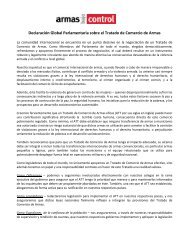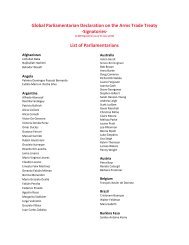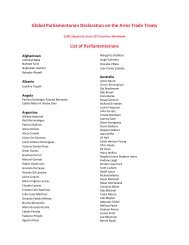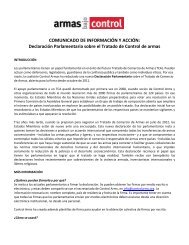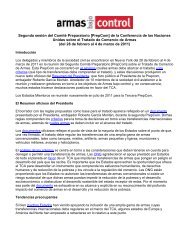Making it Work - Control Arms
Making it Work - Control Arms
Making it Work - Control Arms
- No tags were found...
You also want an ePaper? Increase the reach of your titles
YUMPU automatically turns print PDFs into web optimized ePapers that Google loves.
SAFERWORLD 19While the experience of a number of international regimes would point to the need forsome form of executive inst<strong>it</strong>utional capac<strong>it</strong>y under an ATT, one option may be toexplore whether existing international mechanisms could be adapted in order to meetthe requirements of the agreement. However, <strong>it</strong> is a matter for debate whether therecurrently exists sufficient and appropriate inst<strong>it</strong>utional capac<strong>it</strong>y, for example w<strong>it</strong>hinthe UN, that could be channelled towards meeting these requirements.4.2.3 A role for civilsocietyIn developing inst<strong>it</strong>utional arrangements under an ATT, states should bear in mindthe important role that civil society plays w<strong>it</strong>h regard to encouraging accession to, andmon<strong>it</strong>oring the implementation of, various international regimes.In the arms control sphere the Mine Ban Convention allows all interested parties –including non-government organisations (NGOs) – to fully participate in Meetings ofStates Parties and intersessional meetings of states parties. As well as being present inthe room, NGOs may give presentations to the meetings and make interventions inproceedings.In the environmental sphere, under the CITES, there is provision that enables theSecretariat to be “assisted by su<strong>it</strong>able inter-governmental or non-governmental,international or national agencies or bodies technically qualified in protection,conservation and management of wild fauna and flora”. 28 This has enabled thedevelopment of partnerships between the Secretariat and a number of NGOs thathave been appointed to particular tasks. These include the World Conservation Union(IUCN), <strong>it</strong>s Environmental Law Centre, and TRAFFIC 29 – a joint in<strong>it</strong>iative of theWorld Wide Fund for Nature (WWF) and IUCN. As well as conducting a review ofstates parties’ suggestions for amending the CITES Appendices, the IUCN andTRAFFIC play an important part in assessing the trade in, and status of, species thatare widely traded, as well as in reviewing states parties’ national legislation under theConvention’s national legislation project. Another NGO – the Africa Resources Trust –was tasked w<strong>it</strong>h developing a guide for the CoP meeting in 2000 to help parties toreview and control significant trade in certain species. 30While <strong>it</strong> may not be possible to replicate exactly these types of effort under an ATT,efforts to verify compliance w<strong>it</strong>h Treaty obligations could include the gathering ofcredible and substantiated evidence from civil society. It is certain, moreover, that civilsociety will continue to fulfil an important role in independently assessing levels ofATT implementation by states parties, in a similar way to which NGOs have sought tomon<strong>it</strong>or implementation and encourage progressive development of otherinstruments including the EU Code of Conduct and the UN Programme of Action.ConclusionIn order to function effectively an ATT will require appropriate inst<strong>it</strong>utional arrangements.A minimum requirement would involve the establishment of a Meeting ofStates Parties alongside provision for a formal review of the Treaty every five years.Beyond this the experience from other international regimes suggests that an ATTwould also benef<strong>it</strong> from the establishment of a permanent or semi-permanentexecutive-type inst<strong>it</strong>ution that would be tasked w<strong>it</strong>h overseeing the day-to-dayfunctioning of the regime, including the work of an ATT Secretariat. The establishmentof such an executive-type inst<strong>it</strong>ution would be particularly important w<strong>it</strong>hregard to overseeing any mon<strong>it</strong>oring and verification mechanisms under the regime(see section 5). Finally, where there is scope for civil society to make a pos<strong>it</strong>ivecontribution to the effective functioning of the regime states should support this.28 1973 Convention on International Trade in Endangered Species of Wild Fauna and Flora, Article XII. http://www.c<strong>it</strong>es.org/.29 TRAFFIC, the wildlife trade mon<strong>it</strong>oring network, works to ensure that trade in wild plants and animals is not a threat to theconservation of nature. See: http://www.traffic.org/home/.30 ‘Verification mechanisms in CITES’, Rosalind Reeve, Verification Yearbook 2001, Vertic, London, 2001.



